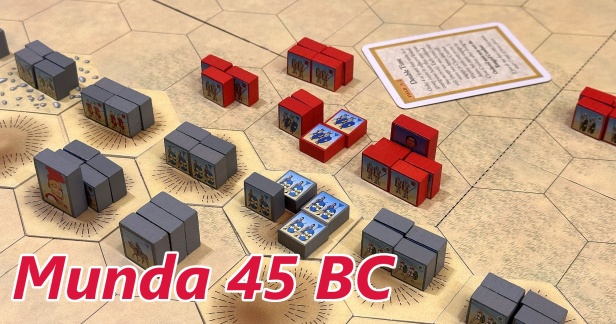Historical Background
Following Julius Caesar’s victory at Thapsus, the remnants of the Pompeian army under Titus Labienus fled to Spain. Here, the garrison legions had revolted in favor of Gnaeus Pompey, the eldest son of Pompey the Great. Pompey gathered a large but largely inexperienced army of thirteen legions. Caesar traveled to Spain to put a final end to Pompeian resistance. He brought three of his crack veteran legions, the 5th, 6th and 10th, but most of his army was also composed of newer recruits. The initial campaign was marked by extreme brutality by both sides, but no decisive battles were fought until Caesar brought Gnaeus Pompey to bay near Munda. Pompey deployed in a strong hill top position so Caesar was faced with an uphill battle. Rather than maneuver for advantage, Caesar uncharacteristically ordered a frontal assault on the strong enemy position. Caesar’s cavalry and light troops attacked both enemy wings but gained no advantage. Some of the hardest fighting in Caesar’s life unfolded as the two armies slogged it out. The Pompeians fought with true desperation, for many of those soldiers had been pardoned by Caesar, and then deserted back to Pompey. For them there would be no second chances. Finally, Caesar’s 10th legion on the right managed to push the opposing forces back. Pompey, under council of Labienus, ordered troops to move from his right to the threatened left flank. Caesar’s cavalry on the left saw the move and made a mighty charge that pushed back the Pompeian right wing. The faltering of both wings eventually caused the raw legions in Pompey’s center to bolt back toward the town. About 30,000 Pompeians died – most slaughtered in the rout. Gnaeus Pompey died with them, and also Titus Labienus, Caesar’s trusted aide who became his bitter opponent. Caesar had won the battle, but later said “he had fought many times for victory, but at Munda he fought for his life.” With his victory at Munda, Caesar finally brought the civil war to an end. Caesar returned to Rome and became “Dictator for Life.” Peace did not last long as Caesar only ruled until March 15, 44 BC when he was assassinated.
The stage is set. The battle lines are drawn and you are in command. The rest is history.

War Council
Pompeian Army
• Leader: Gnaeus Pompey
• 8 Command Cards
Caesarian Army
• Leader: Caesar
• 12 Command Cards
• Move First ![]()
Victory
14 Banners
Special Rules
• Julian Legions rule is in effect for both armies.
• Julius Caesar Rule is in effect.

